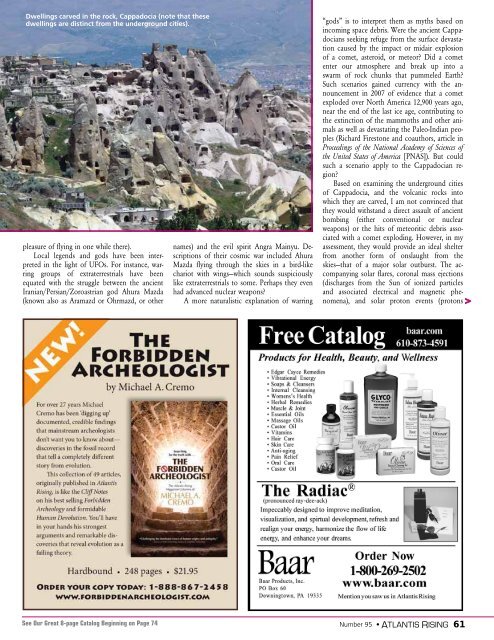Do We Know What We Think We Know About ... - TheUFOStore.com
Do We Know What We Think We Know About ... - TheUFOStore.com
Do We Know What We Think We Know About ... - TheUFOStore.com
You also want an ePaper? Increase the reach of your titles
YUMPU automatically turns print PDFs into web optimized ePapers that Google loves.
Dwellings carved in the rock, Cappadocia (note that these<br />
dwellings are distinct from the underground cities).<br />
pleasure of flying in one while there).<br />
Local legends and gods have been interpreted<br />
in the light of UFOs. For instance, warring<br />
groups of extraterrestrials have been<br />
equated with the struggle between the ancient<br />
Iranian/Persian/Zoroastrian god Ahura Mazda<br />
(known also as Aramazd or Ohrmazd, or other<br />
See Our Great 8-page Catalog Beginning on Page 74<br />
names) and the evil spirit Angra Mainyu. Descriptions<br />
of their cosmic war included Ahura<br />
Mazda flying through the skies in a bird-like<br />
chariot with wings—which sounds suspiciously<br />
like extraterrestrials to some. Perhaps they even<br />
had advanced nuclear weapons?<br />
A more naturalistic explanation of warring<br />
“gods” is to interpret them as myths based on<br />
in<strong>com</strong>ing space debris. <strong>We</strong>re the ancient Cappadocians<br />
seeking refuge from the surface devastation<br />
caused by the impact or midair explosion<br />
of a <strong>com</strong>et, asteroid, or meteor? Did a <strong>com</strong>et<br />
enter our atmosphere and break up into a<br />
swarm of rock chunks that pummeled Earth?<br />
Such scenarios gained currency with the announcement<br />
in 2007 of evidence that a <strong>com</strong>et<br />
exploded over North America 12,900 years ago,<br />
near the end of the last ice age, contributing to<br />
the extinction of the mammoths and other animals<br />
as well as devastating the Paleo-Indian peoples<br />
(Richard Firestone and coauthors, article in<br />
Proceedings of the National Academy of Sciences of<br />
the United States of America [PNAS]). But could<br />
such a scenario apply to the Cappadocian region?<br />
Based on examining the underground cities<br />
of Cappadocia, and the volcanic rocks into<br />
which they are carved, I am not convinced that<br />
they would withstand a direct assault of ancient<br />
bombing (either conventional or nuclear<br />
weapons) or the hits of meteoritic debris associated<br />
with a <strong>com</strong>et exploding. However, in my<br />
assessment, they would provide an ideal shelter<br />
from another form of onslaught from the<br />
skies—that of a major solar outburst. The ac<strong>com</strong>panying<br />
solar flares, coronal mass ejections<br />
(discharges from the Sun of ionized particles<br />
and associated electrical and magnetic phenomena),<br />
and solar proton events (protons<br />
Number 95 • ATLANTIS RISING 61<br />
>


